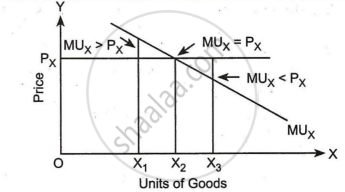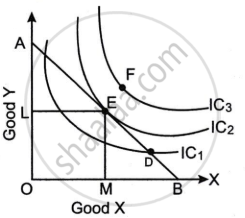Advertisements
Advertisements
प्रश्न
With the help of a diagram, explain how the consumer will attain equilibrium on the consumption of a single commodity at a given price.
उत्तर
- A consumer's equilibrium is a condition in which the benefit obtained from a commodity is equal to the price of the commodity. As a result, the following conditions must be met for a consumer to be in equilibrium:
MUx = Px - Also, for a single commodity, the needed condition is MUx = Px. The marginal utility of a commodity decreases when the user consumes more of it. A rational consumer would continue to spend until the marginal utility of items equalled the price. This is the state of consumer equilibrium. This is the point at which a consumer is unwilling to consume any more. This is explained by the table and graphic below:
- If the price is less than the marginal utility, a rational consumer would enhance his overall utility (satisfaction) by consuming more of the commodity. Consumers can raise their total utility by consuming less of a commodity if the price exceeds the marginal utility. The table indicates that consumer equilibrium occurs at the third unit of the commodity. It is at this stage that the necessary condition for the consumer's equilibrium is met. Consumers are unlikely to purchase more than three units of a commodity if their marginal utility is lower than its price. The figure below depicts the consumer's equilibrium in a single commodity instance.
Utility Schedule: Consumer's Equilibrium
| Units of Goods (X) |
Marginal Utility of Good (MUx) |
Price of the Goods (Px) |
Remarks |
| 1 | 20 | 10 | Consumers's equilibrium |
| 2 | 16 | 10 | |
| 3 | 10 | 10 | |
| 4 | 4 | 10 | |
| 5 | 0 | 10 | |
| 6 | -6 | 10 |

APPEARS IN
संबंधित प्रश्न
A Consumer consumes only two goods X and Y. Marginal utilities of X and Y is 4 and 5 respectively. The prices of X and Y are Rs 4 per unit and Rs 5 per unit respectively. Is the consumer in equilibrium? What will be the further reaction of the consumer? Explain.
A consumer consumes only two goods A and B and is in equilibrium. Show that when price of good B falls, demand for B rises. Answer this question with the help of utility analysis
Given the price of a good, how does a consumer decide as to how much of the good to buy?
A consumer consumes only two goods X and Y. If marginal utilities of X and Y are 4 and 5 respectively, and if price of X is Rs 5 per unit and that of Y is Rs 4 per unit is the consumer in equilibrium? What will be further reaction of the consumer? Explain.
A consumer consumes only two goods X and Y whose prices are Rs 5 and Rs 4 respectively. If the consumer chooses a combination of the two goods with marginal utility of X equal to 4 and that of Y equal to 5, is the consumer in equilibrium? Why or why not? What will a rational consumer do in this situation? Use utility analysis
A consumer consumes only two goods, each priced at Rupee one per unit. If the consumer chooses a combination of the two goods with Marginal Rate of Substitution equal to 2, is the consumer in equilibrium? Give reasons. Explain what will a rational consumer do in this situation.
A consumer consumes only two goods X and Y whose prices are Rs 2 and Rs 1 per unit respectively. It the consumer chooses a combination of the two goods with marginal utility of X being 4 and that of Y also being 4, is the consumer in equilibrium ?Give reasons. Explain what will a rational consumer do in this situation. Use Marginal Utility Analysis.
Market for a good is in equilibrium. There is simultaneous “decrease” both in demand and supply but there is no change in market price. Explain with the help of a schedule how it is possible.
Market for a good is in equilibrium. Explain the chain of reactions in the market if the price is (i) higher than equilibrium price and (ii) lower than equilibrium price.
How does the equilibrium price of a ‘normal’ commodity change when income of its buyers falls? Explain the chain effects.
From the following schedule find out the level of output at which the producer is in equilibrium, using marginal cost and marginal revenue approach. Give reasons for your answer.
|
Price per unit (Rs) |
Output (Units) |
Total Cost (Rs) |
|
8 |
1 |
6 |
|
7 |
2 |
11 |
|
6 |
3 |
15 |
|
5 |
4 |
18 |
|
4 |
5 |
23 |
Equilibrium price falls and equilibrium quantity rises when ______
What can lead to change in budget set?
What is the saturation point?
Refer to the diagram given below and answer the questions that follow.

- What does the line AB represent? Why is the line AB negatively sloped? (2)
- At which one of the given points, D, E and F, will the consumer attain equilibrium? Explain. (2)
- Briefly explain why the consumer is not in equilibrium at the other two points. (2)
